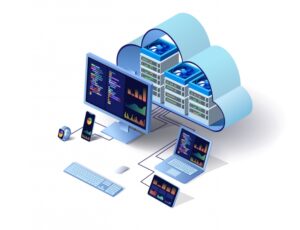Intent-Based Networking for Dummies author Jeff Doyle discusses why IBN, the autonomous, self-provisioning paradigm designed to make network management easier, is the logical evolution of SDN.

Image: caribb, Getty Images/iStockphoto
The main reason companies create content like ebooks, white papers, and blog posts about their products or services is to sell more of that product or service. This is logical and understandable since selling more stuff is why marketing, including content marketing, exists.
Companies also want to showcase their expertise to prospective customers. This is where traditional marketing and content marketing (the area of marketing that deals with ebook creation) diverge. In its simplest form, traditional marketing is all about selling the sizzle, while content marketing is about showcasing the substance. In reviewing the new intent-based networking (IBN) ebook from Apstra, I found myself going into the project guilty of the former and came away focused on the latter.
SEE: Network security policy (TechRepublic Premium)
Intent-Based Networking for Dummies opens by making the business and operational case for why IBN is the next trend in data center networking: Corporate networks are as unique as snowflakes, and they are kept running by the hard work and tribal knowledge of a few (or a few hundred) dedicated engineers and network admins.
From there the ebook does a nice job of laying out the fundamentals of IBN for people who understand networking but have never spent time in the trenches running cables or troubleshooting broken router links. It covers the basics of what IBN is and the challenges it addresses, and then provides good analogies (like flying a plane on autopilot) that makes IBN more approachable.
Even though the ebook is written by uber networking guru Jeff Doyle, whose other works include the 2,000 page tome CCIE Professional Development: Routing TCP/IP, Volume I and II, it does not get mired down in the technical weeds of IBN. Rather, it addresses IBN further up the stack with enough high-level technical detail so that it will be interesting to network engineers but accessible to CIOs as well.
Instead of simply rehashing what’s in the book, I interviewed Doyle, who is currently working with Apstra as a member of its technical team to better understand why IBN is and isn’t the “next big thing” in networking.
SEE: VPN: Picking a provider and troubleshooting tips (free PDF) (TechRepublic)
TechRepublic: Conceptually, the idea of being able to run networks on autopilot sounds very appealing. Does that make IBN the next big trend in networking?
Jeff Doyle: I would say that IBN is not the newer, greater trend. It’s actually part of a continuum of what’s going on in networking that really kind of started with SDN [software defined networking]. Despite the running joke right now that SDN stands for ‘still does nothing,’ I would disagree. Although I like to joke, data centers need that control layer rather than trying to manage individual nodes. What’s really important that comes out of SDN is the idea of seeing the network as a single entity. Basically, abstracting the network out of what’s physically there.
People kind of want to see [IBN] as, ‘Oh, you’re just another automation platform, or you’re just configuration management, or you’re just some sort of a telemetry monitoring application.’ All those sorts of things are all pieces of it, but IBN sort of becomes the cerebral cortex on top of the lizard brain, which has all those other functions. It’s just adding this intelligence to the network.
TechRepublic: What is driving the trend towards more network autonomy?
Doyle: Networks are becoming very complex. And it’s not just the fulfillment versus intent… It’s also looking at, ‘Okay, if I tell the network to do something, how is that going to affect everything else in my network?’ I’ve got certain services running. There’s the consideration of how complex is it to deploy? What are the policies that I need to consider? How does it affect what I already have in my network? Am I going to hurt my existing latency? Am I going to overwhelm certain switches? Am I going to cause TCAM problems in some of my switches?
That’s a lot of very complex considerations because networks are complex and that’s what intent-based networking does is take care of looking at all those configurations. So, when you say, ‘I want to do this’ [IBN] software comes back to you and says, ‘Perhaps you don’t have the resources here, or this is how it’s going to affect what you’re doing.’ What I consider the bigger part of that is once you have established what your intent is for some technology in your network, IBN continues to monitor that.
TechRepublic: When people think of networking, they are often focused on the last mile, connecting devices like smartphones, printers, card readers, cameras, etc. to the corporate WAN. Is connecting those types of devices what IBN is all about?
Doyle: It’s more preparing the network for whatever [you want to do]. If you look at card readers and cameras and all those kinds of things, if you think of all those as applications, which they are, at some point they use the network. What IBN is doing is not necessarily dealing with those applications themselves, but looking at the application requirements for the network and setting the network accordingly to be able to support those efforts.
I’ve been in consulting since the ’80s. It seems like every engineer will have their own idea of what’s the best way to implement things. You end up with networks where individual devices are configured differently and policies are configured differently, protocols are configured differently… because you’ve had a lot of different fingers in the pie.
That’s one of the advantages of IBN. IBN is saying, ‘This is the best practice, how to configure whatever it is you are wanting to do with your network. And… it’s implemented exactly the same way. So, all of your devices should look the same.”
TechRepublic: How much AI is involved? This sounds like a technology that could lean heavily on AI.
Doyle: In some ways, and I certainly would not want to say that that’s not going to be a piece in the future. But, for what we’re doing right now, it’s not. We typically stay away from machine learning.
TechRepublic: What stage are we at in the evolution of IBN today?
Doyle: In my opinion, very early days. When you look at what the promises of IBN are, and this is strictly my own opinion, at some point you should be able to operate your network without having people trained in all of the different operating systems that go into your network.
Also see
Source of Article




